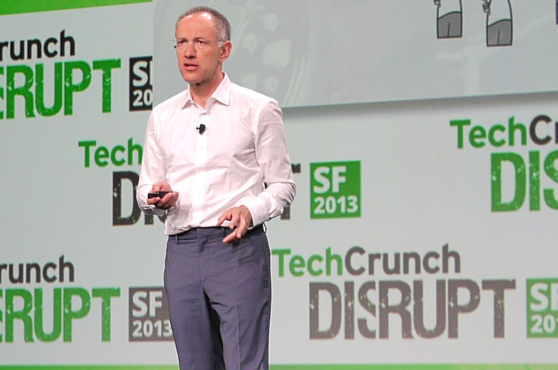Yahoo CEO Marissa Mayer has a vision for the company, and we have a vision for her. Does Marissa Mayer have an ambition gap? Listen to the podcast here:
[audio:https://kontrary.com/wp-content/uploads/2013/09/MarissaMayerpodcast.mp3|titles=Does Marissa Mayer have an Ambition Gap?]
Transcript of this podcast:
Earlier this month, Comscore released numbers that showed, for the first time since 2011, Yahoo beat Google in traffic; Yahoo’s unique visitors were up by roughly 20% compared to July of last year, when the company came in third behind Google and Microsoft. For Marissa Mayer, it’s a success as one of the most scrutinized CEOs in America.
Hello and welcome to Kontrary, a different take on work and life. I’m Rebecca Thorman. Today, we’re going to talk about Yahoo CEO Marissa Mayer and vision – first, her vision for Yahoo, and second, our vision for Mayer.
Let’s start with the recent profile in Business Insider, which they describe as an unauthorized biography. You can basically skip over the beginning which is really boring and not well-written at all, and start paying attention once you get to the lower bits about the transition from interim Yahoo CEO Ross Levinsohn to Mayer, and the dichotomy between their two strategies, which is essentially the decision between whether Yahoo is a technology company or a media company.
Marissa Mayer is a product visionary vs. Ross Levinsohn who is a businessman. Levinsohn was the interim CEO from May of 2012 until July 16, when Mayer took over, and was lead to believe he had the job. The strategy he presented to the Yahoo board was this:
Eliminate the majority of Yahoo’s products, increase Yahoo’s EBITDA (a fancy accounting phrase for income) by 50%, cut the workforce down to 4000 employees, and turn Yahoo into a media company. So essentially Levinsohn would be laying off 11,000 employees in order to make Yahoo profitable. From a purely economic standpoint this may makes sense, but it’s really devoid of any heart or inspiration.
Now remember, he’s been told to run Yahoo as if he will be and already is the full-time CEO. So he sends an email to all employees, and it’s this very typical rah-rah email, telling people, “I’m fired up and I hope you are too. I believe in the power of what we’re doing. We have an incredibly talented team, unparalleled strengths in key areas and most importantly, I see the purple pride building everywhere. Let’s move forward quickly with conviction and confidence.” Now, if I were a Yahoo employee, I can’t imagine getting that email one month, and then, if Levinsohn had been installed as the permanent CEO, being laid off the next month, or hanging around as one of the few remaining employees left.
The morale would have totally tanked. The purple pride would have turned black.
Levinsohn’s plan is very similar to the course of action that AOL took as well. AOL was founded in DC, I worked on their campus as part of a startup incubator for nine months in the past year. And I want to describe the campus. When you near the headquarters, there are all these identical buildings in a typical corporate park, and what you come to realize is that they all used to be owned by AOL, but now have the Raytheon logo emboldened on their side, which is a defense contractor. And there’s just one building left for AOL.
And it’s a beautiful building and workplace, to give it credit, and while the lunches aren’t free, the food is great with a lot of healthy options, there’s tons of natural light and so on and so forth. But the feeling at AOL and in the building is very dead. There are whole sections that are essentially abandoned. They’re not even blocked off, just abandoned and anyone can walk through and see the rows upon rows of empty cubicles under a set of dim lights. It’s depressing. And it’s this constant reminder that the company used to be something else entirely.
And I can imagine that Yahoo would have experienced a very similar downturn, and rather than Levinsohn’s plan bucking the system and reinvigorating the company, it would have taken a very long time to recover, because that’s just what happens with change, especially with something as drastic as that.
Levinsohn is a businessman, he’s about the content, and the bottom line.
Now, in contrast, the beauty of Mayer’s plan is that she believes. She believes in Yahoo and she believes in Yahoo products. She wants Yahoo to be a technology company. In the Business Insider piece, they describe how Yahoo employees created posters in the style of the first Obama campaign election, but instead of Obama’s face, Mayer’s face appears with the word Hope inscribed across the bottom. Think about that. Mayer’s plan is just as drastic as Levinsohn; there will be just as much change, but it’s centered around creating something, instead of tearing something down. Mayer’s vision is about lifting up, instead of giving up.
While some people thought Mayer came off negatively in the Business Insider piece, I really thought she came off as a bit of a hero, or at the very least a compelling leader; her vision has heart and stays true to this notion of innovation, that of going after something larger than yourself or the shareholder’s bottom line.
One of the featured comments at the end of the BI piece actually says:
Yahoo is lucky to have Marissa as CEO. She has done what none of the previous CEOs could do. She has inspired Yahoo employees and [gave] them confidence…
And another:
My high school senior is devouring the article, and hopefully she draws inspiration from a talented and driven Marissa.
And I think that’s how a lot of women feel. We’ve created our own vision of Mayer, and are all looking up or at least over at Mayer to see what she does. She’s become a role model, and that brings responsibility, whether you like it or not.
And with responsibility, comes a lot of pressure. In an article on Time, Charlotte Alter writes:
Mayer still describes her success as almost effortless. ‘It’s not like I had a grand plan where I weighed all the pros and cons of what I wanted to do,’ she told Weisberg, ‘It just sort of happened.’
It’s a misguided attempt at modesty, but it’s the same ‘little ol’ me’ rhetoric that Mayer’s friend Sheryl Sandberg is trying so hard to stamp out. And it’s the same fairy tale reasoning that girls have internalized for generations; girls don’t ‘do’ things, things ‘just happen’ to them.
Pando Daily’s Sarah Lacy responds, first by defending Mayer a bit:
Marissa Mayer isn’t actually allowed to make decisions for herself, her company and her family– somehow we all read those to be decisions she is making for the world.
and then draws a line in the sand:
We’re seriously supposed to believe Mayer just accidentally landed in a top CEO job? … Not owning up to a certain level of ambition is not only disingenuous, but it perpetuates the idea to the young ambitious women reading Vogue that ambition is somehow bad.
Leaders, regardless of their position, are always role models. It is part of the gig, inescapable, just by assuming such a position. While I find it hard to believe that Mayer doesn’t realize this, I also wonder, how far can we go in deciding and assigning responsibility? Our institutional leaders are only human, but man, if we don’t wish them to be more.
While I agree with both Pando Daily and Time, I don’t agree with the people who criticized Mayer’s recent Vogue profile and photo shoot. Is it disingenuous to make judgement on one message and not the other?
To answer that, let me share what Jezebel founder Anna Holmes has to say:
Ms. Mayer’s Vogue profile make me yearn for a time when female competence in one area is not undermined by enthusiasm for another, in which women in positions of power are so commonplace that we do not feel compelled to divine motive or find symbolism in every remark they make, corporate policy they enact or fashion spread they pose for.
I’ll end there. We’ve been talking about Marissa Mayer, CEO of Yahoo, the most scrutinized CEO in America, and her vision for Yahoo, and our vision for her. I’m Rebecca Thorman, and this is Kontrary, a different take on work and life, broadcasting from Washington, DC. Talk to you soon.
What do you think? Is Marissa Mayer’s vision for Yahoo the right one? And is our vision for Marissa Mayer fair? Should she try harder or is she doing well?
 I just… the insanity of this… “Flipboard, the online news magazine app, has raised $50m at a $800m valuation, which is almost 50% of the market cap of The New York Times Company at $1.75 billion.” A near-billion dollar valuation?
I just… the insanity of this… “Flipboard, the online news magazine app, has raised $50m at a $800m valuation, which is almost 50% of the market cap of The New York Times Company at $1.75 billion.” A near-billion dollar valuation?